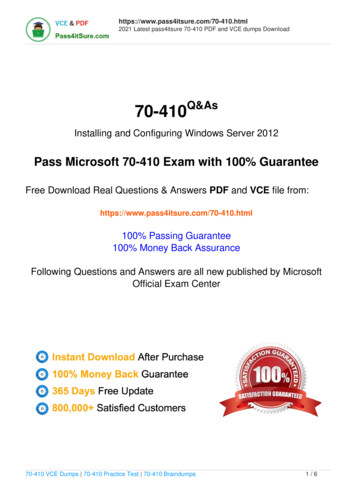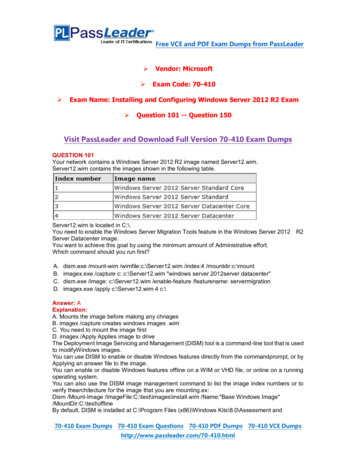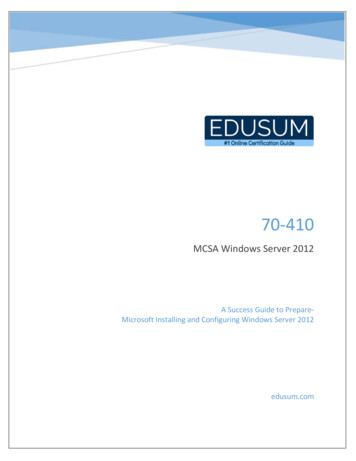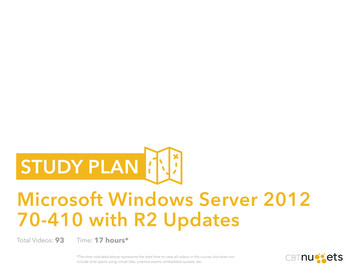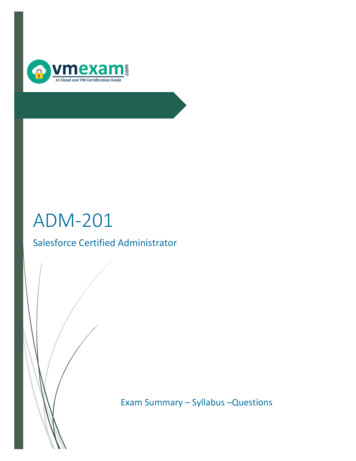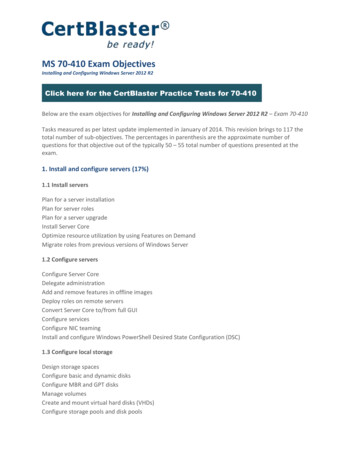
Transcription
MS 70-410 Exam ObjectivesInstalling and Configuring Windows Server 2012 R2Click here for the CertBlaster Practice Tests for 70-410Below are the exam objectives for Installing and Configuring Windows Server 2012 R2 – Exam 70-410Tasks measured as per latest update implemented in January of 2014. This revision brings to 117 thetotal number of sub-objectives. The percentages in parenthesis are the approximate number ofquestions for that objective out of the typically 50 – 55 total number of questions presented at theexam.1. Install and configure servers (17%)1.1 Install serversPlan for a server installationPlan for server rolesPlan for a server upgradeInstall Server CoreOptimize resource utilization by using Features on DemandMigrate roles from previous versions of Windows Server1.2 Configure serversConfigure Server CoreDelegate administrationAdd and remove features in offline imagesDeploy roles on remote serversConvert Server Core to/from full GUIConfigure servicesConfigure NIC teamingInstall and configure Windows PowerShell Desired State Configuration (DSC)1.3 Configure local storageDesign storage spacesConfigure basic and dynamic disksConfigure MBR and GPT disksManage volumesCreate and mount virtual hard disks (VHDs)Configure storage pools and disk pools
Create storage pools by using disk enclosures2. Configure server roles and features (17%)2.1 Configure file and share accessCreate and configure sharesConfigure share permissionsConfigure offline filesConfigure NTFS permissionsConfigure access-based enumeration (ABE)Configure Volume Shadow Copy Service (VSS)Configure NTFS quotasCreate and configure Work Folders2.2 Configure print and document servicesConfigure the Easy Print print driverConfigure Enterprise Print ManagementConfigure driversConfigure printer poolingConfigure print prioritiesConfigure printer permissions2.3 Configure servers for remote managementWinRMConfigure down-level server managementConfigure servers for day-to-day management tasksConfigure multi-server managementConfigure Server CoreConfigure Windows FirewallManage non-domain joined servers3. Configure Hyper-V (18%)3.1 Create and configure virtual machine settingsConfigure dynamic memoryConfigure smart pagingConfigure Resource MeteringConfigure guest integration services
Create and configure Generation 1 and 2 virtual machinesConfigure and use enhanced session mode3.2 Create and configure virtual machine storageCreate VHDs and VHDXConfigure differencing drivesModify VHDsConfigure pass-through disksManage snapshotsImplement a virtual Fiber Channel adapterManage checkpointsConfigure storage Quality of Service (QoS)3.3 Create and configure virtual networksImplement Hyper-V Network VirtualizationConfigure Hyper-V virtual switchesOptimize network performanceConfigure MAC addressesConfigure network isolationConfigure synthetic and legacy virtual network adaptersConfigure network interface card (NIC) teaming in virtual machines4. Deploy and configure core network services (17%)4.1 Configure IPv4 and IPv6 addressingConfigure IP address optionsConfigure subnettingConfigure supernettingConfigure interoperability between IPv4 and IPv6Configure ISATAPConfigure Teredo4.2 Deploy and configure Dynamic Host Configuration Protocol (DHCP) serviceCreate and configure scopesConfigure a DHCP reservationConfigure DHCP optionsConfigure client and server for PXE bootConfigure DHCP relay agentAuthorize DHCP server
4.3 Deploy and configure DNS serviceConfigure Active Directory integration of primary zonesConfigure forwardersConfigure Root HintsManage DNS cacheCreate A and PTR resource records5. Install and administer Active Directory (14%)5.1 Install domain controllersAdd or remove a domain controller from a domain; upgrade a domain controllerInstall Active Directory Domain Services (AD DS) on a Server Core installationInstall a domain controller from Install from Media (IFM)Resolve DNS SRV record registration issuesConfigure a global catalog serverDeploy Active Directory infrastructure as a service (IaaS) in Windows Azure5.2 Create and manage Active Directory users and computersAutomate the creation of Active Directory accountsCreate, copy, configure, and delete users and computersConfigure templatesPerform bulk Active Directory operationsConfigure user rightsOffline domain joinManage inactive and disabled accounts5.3 Create and manage Active Directory groups and organizational units (OUs)Configure group nestingConvert groups including security, distribution, universal, domain local, and domain globalManage group membership using Group PolicyEnumerate group membershipDelegate the creation and management of Active Directory objectsManage default Active Directory containersCreate, copy, configure, and delete groups and OUs6. Create and manage Group Policy (16%)
6.1 Create Group Policy objects (GPOs)Configure a Central StoreManage starter GPOsConfigure GPO linksConfigure multiple local group policiesConfigure security filtering6.2 Configure security policiesConfigure User Rights AssignmentConfigure Security Options settingsConfigure Security templatesConfigure Audit PolicyConfigure Local Users and GroupsConfigure User Account Control (UAC)6.3 Configure application restriction policiesConfigure rule enforcementConfigure AppLocker rulesConfigure Software Restriction Policies6.4 Configure Windows FirewallConfigure rules for multiple profiles using Group PolicyConfigure connection security rulesConfigure Windows Firewall to allow or deny applications, scopes, ports, and usersConfigure authenticated firewall exceptionsImport and export settings
MS 70-410 Exam Objectives Installing and Configuring Windows Server 2012 R2 Click here for the CertBlaster Practice Tests for 70-410 Below are the exam objectives for Installing and Configuring Windows Server 2012 R2 – Exam 70-410 Tasks meas
